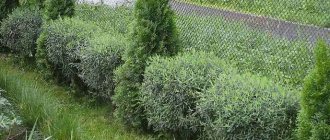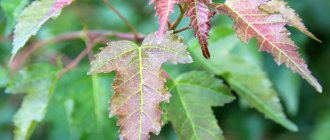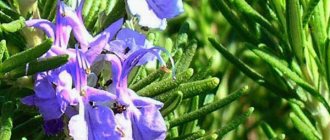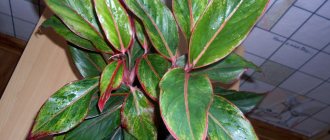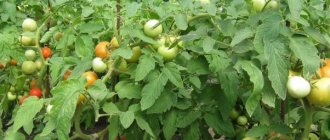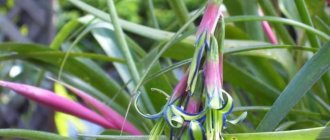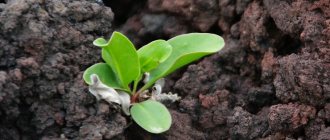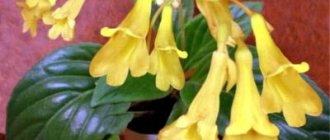Colchis boxwood (also called buxus) is a unique plant that is found in the wild only in the Caucasus. A beautiful shrub can be turned into a ball, a geometric figure, or even into entire compositions. The tree does not require much care, but it grows very slowly, so it requires caution, especially when pruning.
Colchian boxwood lives up to 600 years, but grows slowly: 3 m in 50 years; reaches a height of no more than 15 m
What does Colchian boxwood look like?
This is a beautiful tree or shrub that reaches a height of 12 and sometimes 15 meters (young specimens are no more than 2 m). It has great decorative value due to its beautiful foliage and the ability to be pruned to form the desired look.
The classic form of pruning is in the form of a ball.
Description of Colchis boxwood:
- The leaves are deep green in color and arranged oppositely.
- The surface of the leaf is leathery, smooth to the touch, the leaves are small in length - up to 3 cm, and resemble an elongated oval in shape.
- The growth of shoots is very slow: the trunk increases annually by only 1 mm, and older branches begin to be covered with bark.
- Colchian boxwood blooms in May, and only 20-25 years after planting. The flowers are yellowish and have a pleasant aroma.
- After flowering, fruits are formed that resemble boxes, inside of which there are small black seeds.
Boxwood fruits are spherical, yellow-green in color
Colchian boxwood: description. Boxwood evergreen
Colchis boxwood is of some interest to scientists. This relict plant can reveal the secrets of bygone eras. Human activity causes significant harm to plant numbers, but there is still hope that the species will survive. What kind of plant is this, what does it look like, how to preserve it? Let's figure it out together.
What does relic mean?
“Relic” is not just a fancy term. This is the name given to plants that have survived in certain areas of the Earth since ancient times, despite the fact that natural conditions have changed greatly. Relics are modest remains of ancestral groups that have come down to us from past geological eras. The word “relic” is translated from Latin as “remaining.”
The study of relict plants gives scientists information about the nature of past eras. This is what arouses the interest of scientists in relation to boxwood Colchis, a modest inhabitant of the ancient forests of Colchis.
Scientific classification
Boxwood Colchis belongs to flowering plants from the genus Boxwood. The family to which this species belongs is called Boxwood. In scientific circles, the Latin name of the species is used - Buxus colchica. Some sources claim that the synonym for this species is boxwood evergreen. However, not everyone agrees with this; according to other sources, these are simply very close species.
Botanical description
The plant is an evergreen shrub or tree. There is a complete external resemblance to evergreen boxwood. The height of the species varies from 2 to 20 m, the base of the trunk can reach up to 30 m in diameter. The foliage is leathery, glabrous, mostly opposite. The shape of the leaf blades is oval-lanceolate, leaf length is up to three centimeters.
Colchis boxwood has light green foliage. The crown of a bush or tree is so dense that it does not allow light to pass through. Of all the European boxwood species, this plant has the smallest foliage.
Lifespan is up to 600 years. A characteristic feature of the plant is that evergreen boxwood (Colchian) grows very slowly. Its annual rings are small, in fact they are difficult to distinguish on the cutting.
The average growth rarely exceeds 0.5 cm in diameter.
Flowering occurs in April-May. At this time, a pleasant aroma hovers around the plants. The flowers are small, light yellow. They are collected in capitate inflorescences located in the axils of the leaves. In summer, the fruit ripens in a capsule, which scatters small black seeds. Seed dispersal is possible up to three meters from the parent bush.
Where is it found?
Colchian boxwood grows in Azerbaijan, Abkhazia, Georgia, the Russian Federation and Turkey. The main places of growth are the Black Sea coast. The plant thrives at altitudes up to 1800 m above sea level.
It is found in the form of a shrub in some European countries (France, Spain, Switzerland, Greece). There are scattered plantings in China, the Himalayas and India.
What else can be said about the distribution of such a plant as Colchian boxwood? We will continue the description with an important feature of the species - its high shade tolerance. Of all tree species, boxwood has the highest rate. The shrub and trees may grow in shady canyons or under dense forest canopy. This in some way contributes to the conservation of the species.
How boxwood was used
Now boxwood has lost its economic importance, since it cannot be harvested and cut down due to the small number of plants. But previously, wood of this type was highly valued.
The fact is that it has a beautiful color, close to ivory, a uniform structure and high density. At the same time, the wood lends itself well to processing and polishing.
The local population still uses boxwood to make souvenirs, candlesticks, cups, mortars and combs.
Due to the high value of wood, boxwood plantings have suffered greatly in the past. Their felling was carried out haphazardly, and almost no care was taken about restoration. For example, from 1840 to 1928, more than 90 tons of valuable wood were sold abroad from Russia, while a huge part of the felled trees were never removed from the forest, and they were gradually stolen.
A small mistake with serious consequences
Human activity makes adjustments to the surrounding nature. Unfortunately, these changes are not always with a “+” sign. The places where the species can grow are rapidly shrinking. What happens to a plant like Colchian boxwood? The Red Book designates this species as endangered. Accordingly, it is necessary to take measures to preserve it. But not everything is so smooth here either...
In 2012, in preparation for the Olympic Games in Sochi, it was decided to plant a large amount of boxwood. Planting material was ordered from nurseries in Italy, but an invasive pest, the boxwood moth, was brought in with it. As a result, a good initiative turned into a huge problem.
The pest began mass destruction of boxwood plantings in the Sochi region. At the same time, the yew-boxwood grove, which is a monument of ancient nature (the eastern slope of Mount Akhun, Krasnodar Territory), suffers greatly. So far they are not trying to stop the threat, which means that man has once again put Colchian boxwood under the threat of complete extinction.
Whether the situation can be corrected, time will tell.
Colchian boxwood: interesting facts
There are many interesting facts associated with the plant. So, for example, on Palm Sunday we decorate our houses with willow branches, and Catholics in many Western European countries decorate their houses with boxwood branches.
The Adyghe people considered boxwood trees sacred. Large specimens of the Colchis species are still revered by the local population.
Flowering boxwood is an excellent honey plant, but honey should not be consumed in large quantities. It may have a mild hallucinogenic effect.
Bushes and trees, and especially plantings of Colchian boxwood, tolerate winter well. They don’t need to be covered in ten-degree frost.
To preserve a relict species, it is advisable to take the following measures: plant plants in protected areas, fight pests, monitor the state of the species’ populations, and organize its protection. You can also cultivate boxwood in botanical gardens.
Source: https://FB.ru/article/289532/samshit-kolhidskiy-opisanie-samshit-vechnozelenyiy
Plant listed in the Red Book - Colchian boxwood
Colchis boxwood is a species of flowering plant. The plant belongs to the genus Boxwood and the Boxwood family.
According to some sources , this plant is a synonym for a species such as Evergreen Boxwood or its very close species.
general description
It grows under natural conditions in the Krasnodar region, in the basins of rivers such as Belaya and Laba. In addition, it is found in the Northwestern Caucasus and on the southern slopes of the Greater Caucasus from Tuapse, including the Mzymta River basin, and is found in Georgia and Asia Minor. Also found in Turkey.
Although boxwood regenerates well, its growth rate is very low . In nature, its lifespan can reach 600 years. And at 200-250 years, the thickness of its trunk is approximately 30 cm in diameter.
Boxwood can be either a shrub or a tree . The plant is evergreen. The plant reaches a height of 2 - 12 meters. Its leaves are usually bare and leathery. For the most part, they are opposite. The leaf blade is oval-lanceolate, its length is usually 1-3 cm.
The flowers are usually yellow-green in color and are collected in axillary capitate inflorescences.
Photos
Colchian boxwood: photo of this plant species.
Care after purchase
If the boxwood was purchased in a store, this means that it was planted in soil that is not suitable for it. In technical conditions, all plants are planted in the simplest transport pots; in addition, the soil is not suitable. It often happens that a plant dies from injury to the root system. Therefore, there is no need to free the roots from the soil clod.
It would be optimal to transfer it into a slightly larger pot. The new pot should be selected so that your finger fits between the root ball and the edge of the pot. You should not take a very large pot; transplanting immediately into a large container will have a bad effect on the plant.
Watering
In summer, the plant needs abundant watering.
In winter , watering should not be intensive. You should be guided by weather conditions and water as the soil dries out.
Bloom
The flowers are axillary spikes. They are unisexual, yellow in color, at the bottom of the spike there are numerous male flowers (with stamens), and at the top there are female flowers with pistils.
fruit is a triangular capsule. This box opens along the doors.
But only an adult plant can please us with its flowering. The first flowering usually occurs in a plant that is 20-25 years old.
Crown formation
Crown formation is usually not difficult. It is advisable to prune in spring or summer.
Keep in mind that boxwood grows slowly and the green mass will not grow immediately. This means that if the crown is cut off radically, its fouling will take a long time.
Ground, soil
Boxwood is little affected by the composition of the soil; the main thing for it is good drainage . Any fertile soil with a neutral pH will do (it should be close to 5.5).
Usually a mixture of 1 part coniferous soil, 2 parts deciduous soil and 1 part sand is used. Vermiculite or perlite is used. It would be nice to have birch charcoal in the soil mixture.
Planting and transplanting
Replanting is carried out annually, the soil for it is used with a neutral pH . Be sure to provide good drainage.
Reproduction
Reproduction occurs by cuttings and seeds .
Cuttings
It is problematic to propagate boxwood by cuttings ; rooting them takes a long time and is very difficult.
If you want to propagate it by cuttings, then cut the cuttings towards the end of summer. You need to choose cuttings that are semi-lignified at the base.
Their length should not exceed 7 cm. Cuttings should have 2-3 internodes. In order for them to take root, it is advisable to use phytohormones, such as rootin, heteroauxin and heating the soil in a room greenhouse.
Where does Colchian boxwood grow?
In nature, the tree grows exclusively in the Caucasus:
- South of Russia (Adygea, Krasnodar region);
- Abkhazia;
- Georgia;
- Azerbaijan.
The plant can also be found in Turkey.
Colchian boxwood is found in the natural zone of steppes and mountains (at an altitude of up to 1800 m). It is also found on the Black Sea coast. The tree does not grow in other places - it is endemic to the Caucasus. However, it can be diluted artificially if appropriate conditions are maintained (temperature, humidity, lighting, soil composition).
What does relic mean?
“Relic” is not just a fancy term. This is the name given to plants that have survived in certain areas of the Earth since ancient times, despite the fact that natural conditions have changed greatly. Relics are modest remains of ancestral groups that have come down to us from past geological eras. The word “relic” is translated from Latin as “remaining.”
The study of relict plants gives scientists information about the nature of past eras. This is what arouses the interest of scientists in relation to boxwood Colchis, a modest inhabitant of the ancient forests of Colchis.
Application in landscape design
The tree has a high decorative value, so it is often used to decorate parks, squares and gardens. Thanks to pruning, the bush can be given almost any shape, for example:
- Balls located along the site, along the border of the garden.
- Decorative figures made up of such balls.
- Zigzags and labyrinths from Colchis boxwood.
- Composition of different figures.
- Living row of boxwoods.
- A grove of boxwood balls with birch trees and decorative elements.
- Flowerbed with living frame.
- And even more complex figures.
Application of boxwood
Boxwood is interesting not only because it is a relic. It is of great economic value. Boxwood wood is one of the most valuable. Its quality in some respects exceeds the quality of the wood of all our other tree species. It is beautiful, ivory-colored, uniform in structure, dense and heavy, well processed and polished. The local population uses boxwood wood to make cups, candlesticks, spoons, forks, combs, mortars, shelves, and spindles. Currently, due to the small reserves of boxwood, the use of wood is limited only to the production of various valuable carved and turned products (souvenirs, parts for precision mathematical instruments, etc.)
Wood has lost its former glory because its reserves are almost exhausted. In the past, boxwood wood, for example from Georgia, was highly valued in foreign markets. During the period from 1842 to 1928, more than 90.5 tons of boxwood were exported abroad in the form of raw materials - meter-long cuttings. For this purpose, hundreds of thousands of the best trees were cut down, and only a small part of them was taken out of the forest. Harvesting boxwood was unsystematic and led to tree stands (in ripe and ripening form) to almost complete destruction. Boxwood trees have survived only in hard-to-reach places in the form of clumps, thinned out by logging. But they are also of great value; growing in gorges, they perform water protection, soil protection and often bank protection functions.
Boxwood is considered a valuable honey plant. Previously, its bitter, unpleasant-tasting bark and leaves were used in infusion as a diaphoretic and laxative. The oil extracted from them was recommended against toothache, scabs, etc. Boxwood leaves and branches are considered in some places the best fertilizer for grapes. Sawdust and leaves boiled in lye were used to dye hair chestnut. According to some statements, no animal touches boxwood seeds, and its leaves are considered poisonous to livestock, especially camels. They also claim that the toxicity sometimes inherent in Corsican honey depends on the fact that bees collect nectar and pollen from boxwood flowers.
Due to its eternal greenery, resistance to diseases and damage by insects, boxwood is widely used as a landscaping plant in the creation of parks, squares, as well as hedges and borders.
Features of reproduction
In practice, there are 3 main methods of propagating Colchis boxwood:
- Using seeds. Boxwood has large black seeds (the size of apple seeds). They survive well and germinate almost completely. However, the seedling develops for a very long time - at least 3 years.
- By cuttings - almost all shoots take root. To obtain them, you can select annual shoots (apical and lateral) on lignified branches, the length of the seedling is 10-15 cm. They are planted to a depth of 3 cm and watered abundantly. Transfer to open ground is allowed only after 1 year.
- Layering - for this, choose a long branch of Colchian boxwood, bend it to the ground and partially cover it with soil, give a lot of water and fertilize the soil. It is better to do this in the spring - then the layering will fully form the roots in the fall.
Optimal conditions for growing Colchis boxwood
Since Colchian boxwood grows only in the natural zone of the Caucasus, for its cultivation it is necessary to provide conditions appropriate to the local climate:
- Summer temperatures are consistently above +20 degrees.
- In winter the temperature is about +14, but it should not fall below +5. Temperatures below +10 degrees are considered extremely low.
- High level of humidity - additional moisture is carried out during periods of drought, especially for young seedlings of Colchis boxwood.
- The illumination level is quite bright, but the light should be diffused. Therefore, in summer you need to create a little shade by planting in a shady place.
Thus, in winter, Colchis boxwood must be transferred to a heated room with the temperature maintained at a level not lower than +12, but not higher than +15. In summer, it can again be taken out into the fresh air to provide normal lighting and heating.
In most regions of Russia, boxwood can only be grown in pots
Rules for planting and care
Colchian boxwood does not require special growing conditions, so even novice gardeners can start growing it. Most often, the plant is propagated by seedlings, which can be purchased at a nursery or store. During transportation, you need to be especially careful to ensure that the roots are not damaged.
Since boxwood blooms as early as March, it is usually planted in the fall (early October). The composition of the soil can be different, the soil environment is close to neutral or slightly acidic. The landing technology is as follows:
- Dig holes of shallow depth (the roots should fit tightly to the surface of the earth).
- Drainage made of perlite or small stones is placed at the bottom.
- The pit is well watered (5-10 liters of water) and covered with fertile soil or soil with compost and humus.
- The seedling is planted so that the root collar remains almost invisible. The soil needs to be compacted around the trunk to create a small depression for liquid to enter.
In the future, caring for Colchis boxwood is simple. 3 days after planting, it needs to be watered again, and then mulched with peat and pine needles for the winter (if grown in open ground). There is no need to feed immediately - fertilizers should be applied for the next season, and the frequency should be constant: 2 times a year. The first fertilizing is applied through a sprayer, the second is scattered on the top layer of soil (without prior dilution).
For feeding, you can use complex mineral fertilizer, dilute according to the instructions.
Scientific classification
Boxwood Colchis belongs to flowering plants from the genus Boxwood. The family to which this species belongs is called Boxwood. In scientific circles, the Latin name of the species is used - Buxus colchica. Some sources claim that the synonym for this species is boxwood evergreen. However, not everyone agrees with this; according to other sources, these are simply very close species.
Rules for growing at home
In most cases, the plant is grown at home, since the climatic conditions of many regions of Russia allow it to be transferred to fresh air only in the summer. Therefore, it is useful to pay attention to several features of home breeding:
- The containers should not be too spacious, otherwise the shoots will grow slowly.
- You can choose practically any soil - universal, garden, for flowers. You can get it yourself, for example, by mixing turf, leaf soil and sand in a ratio of 4:2:1. At the same time, there is no need to add peat - it harms the development of boxwood.
- Transplantation is carried out in the spring. Since Colchian boxwood grows very slowly, it is enough to repeat this procedure once every 3 years, and then even less often (determined visually).
- Colchian boxwood needs diffused light. Light shade can be provided by other plants or a screen.
Attention! All parts of boxwood are poisonous (especially the foliage). Therefore, it is necessary to exclude access to children and pets, at the first signs of poisoning, induce vomiting and immediately consult a doctor.
Features of growing in open ground
Growing in open ground is allowed only in the regions of the South of Russia - that is, in the natural zone where Colchis boxwood is found in the natural environment. To successfully grow a tree, you must follow fairly simple rules:
- Boxwood needs regular, weekly watering. Moreover, in the warm season it is also necessary to additionally irrigate the foliage. Young seedlings are watered especially abundantly - immediately after planting and 3-5 days later.
- Fertilizing boxwood: twice per season: in the spring the plant is given nitrogenous fertilizers, and closer to wintering - phosphorus and potassium fertilizers.
- Pruning Colchis boxwood is carried out with extreme caution, since its shoots grow extremely slowly. Young bushes look quite attractive and do not need treatment. Mature boxwoods are pruned to obtain the desired shape - usually spherical. You can cut your hair from April to September. Moreover, during this period, they must increase watering and provide additional fertilizing.
To create a semicircular shape on a large Colchian boxwood bush, you will need to cut out a cardboard hemisphere or other template to trim those branches that extend beyond this border
Boxwood care
The main secret of a healthy and beautiful boxwood is proper planting and choice of soil. After this, the bush practically does not cause problems: it is enough to protect it from cold, drafts and wind.
Temperature
Boxwood easily tolerates hot summers and high temperatures up to +35 degrees. The main thing under such conditions is diffused light or light partial shade so that burns do not appear on the leaves.
Cold winter is a difficult period for evergreen shrubs, which are not highly resistant to frost. To prepare, at the end of autumn, carry out strong and abundant deep watering, which will be enough for the whole season. Mulch the area around the root system with pine needles or peat, but not with dry leaves that can rot.
Tie the boxwood to supports and cover it with fabric as soon as the temperature drops below -10 degrees. This applies to standard forms and decorative hedges. A special non-woven material or even ordinary burlap in several layers will do.
Lighting
Boxwood feels good in almost any conditions: in the shade, in direct sun, in diffused light. There are separate varieties for shady regions, and there are southern boxwoods, adapted to heat and scorching sun.
Watering
Usually, natural watering during rainfall is enough for boxwood in open ground - it easily tolerates even short droughts. But if you grow a shrub in a pot or tub, water it daily, and in the hot summer also give it a small shower.
Fertilizers and fertilizing
Tub varieties require feeding from mid-spring to late summer. To avoid burning the rhizome, use solutions diluted in warm water based on specialized mixtures specifically for boxwood. A common problem is the appearance of red and brown leaves, which indicates a lack of nitrogen.
Trimming
Boxwood is a lush shrub that can be shaped at your discretion, so it needs pruning regularly. It is best to do it in mid-spring - it will not cause him any harm. On the contrary, boxwood that is regularly pruned grows faster, thicker and more luxuriantly.
Most often, gardeners form balls and cones from shrubs, which look elegant with neat rounded leaves. The shape does not need to be changed regularly: it is enough to give it once and then maintain it. You can trim boxwood every month, but the more often you do it, the more intense the watering and fertilizing should be so that the plant restores its resources.
You can even form a neat decorative tree from boxwood to decorate your site. Cut off completely all the lower shoots and stems, except for the strongest and strongest in the center. Soon new branches will begin to sprout on it, which can be shaped into a spherical crown.
Why Colchis boxwood is listed in the Red Book
Boxwood Colchis is listed in the Red Book of Russia with the mark “species declining in numbers.” Today, according to various sources, there are from 20 to 100 thousand copies of this plant in the wild. It is believed that about 15 million years ago very large boxwood forests grew on the territory of Russia. However, the bushes were subsequently replaced by other plants and trees.
Currently, the main reason for the disappearance of the tree is considered to be the active influence of the pest – the boxwood moth. The fact is that in the natural environment this insect has no enemies (at least in the ecosystem of the Caucasus). Therefore, the moth multiplies quickly and eats boxwood foliage. The situation is complicated by the fact that it is recovering extremely slowly.
Important! Today, more than 99% of all boxwood specimens in the Caucasus have been destroyed, so the plant is on the verge of extinction.
Boxwood is damaged by both caterpillars and boxwood moth butterflies.
Botanical description
The plant is an evergreen shrub or tree. There is a complete external resemblance to evergreen boxwood. The height of the species varies from 2 to 20 m, the base of the trunk can reach up to 30 m in diameter. The foliage is leathery, glabrous, mostly opposite. The shape of the leaf blades is oval-lanceolate, leaf length is up to three centimeters.
Colchis boxwood has light green foliage. The crown of a bush or tree is so dense that it does not allow light to pass through. Of all the European boxwood species, this plant has the smallest foliage. Lifespan is up to 600 years. A characteristic feature of the plant is that evergreen boxwood (Colchian) grows very slowly. Its annual rings are small, in fact they are difficult to distinguish on the cutting. The average growth rarely exceeds 0.5 cm in diameter.
Flowering occurs in April-May. At this time, a pleasant aroma hovers around the plants. The flowers are small, light yellow. They are collected in capitate inflorescences located in the axils of the leaves. In summer, the fruit ripens in a capsule, which scatters small black seeds. Seed dispersal is possible up to three meters from the parent bush.
Diseases and pests
Despite its toxicity, Colchis boxwood is still susceptible to diseases and pests. Among the main lesions, the most common are fungal ones (powdery mildew, rust, gray rot and others). Fungicides, Bordeaux mixture and other drugs are used for treatment and prevention.
When the first signs of the disease appear, the affected shoots should be removed immediately
The main tree pests are:
- boxwood moth (the most dangerous insect);
- spider mite;
- boxwood gall midge;
- boxwood flea.
To save the plant, you first need to remove and destroy the pests manually (if possible). Next, you will need to treat the tree with insecticides such as “Actofit”, “Lepidotsid-BTU”, “Bitoxibacillin-BTU”.
Advice! During pest control, the feeding regime should be changed. For example, at this time the application of nitrogen fertilizers is completely stopped and potassium sulfate is given in the amount of 20 g per 10 liters of water.
